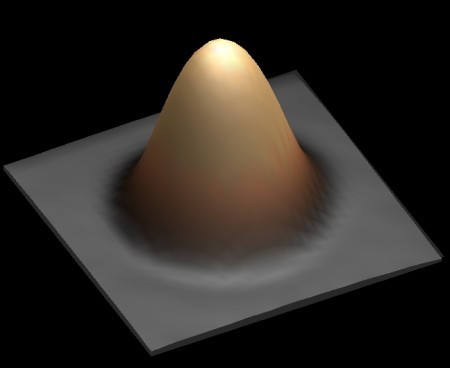IBM has written a bit of information in one atom

The world's smallest magnet, 2017. Photo: IBM
The international team, led by teams from the IBM Almaden Research Center and the Federal Polytechnic School in Lausanne, approached the absolute limit of the classical approach to storing information on physical media. Scientists have created the world's smallest magnet on a single atom and recorded there 1 bit of data. To understand: on the most modern HDDs, approximately 100,000 atoms are used to record one bit.
Writing and reading information at the atomic level opens up incredible opportunities for creating smaller drives and larger capacity.
Until now, the maximum limit of addressable bistable magnetic bits was clusters of 3-12 atoms . At the same time, long periods of magnetic relaxation have been proven for individual lanthanide atoms in molecular magnets, lanthanides in crystals, and recently in holmium atoms (Ho) on an insulating substrate of magnesium oxide (MgO).
')
Lanthanides - a family consisting of 15 rare earth metals, with atomic numbers 57-71 (from lanthanum to lutetium). All lanthanides from cerium to ytterbium are filled with a 4f subshell. Unpaired 4f-electrons impart to some of these metals unique magnetic properties (for example, in neodymium).
So, as a result of recent experiments, it became clear that individual atoms of lanthanides are capable of maintaining a magnetic state for a long time. These results indicated a clear path for further experiments that would allow for the actual storage of information at the atomic level. There remained only one technological problem - how to get access to the individual magnetic centers of the atoms, that is, how in practice to read the state in a reliable and accurate way?
Now researchers from IBM Almaden Research Center managed to solve this problem . They found a way to magnetize individual atoms and proved that the magnetized state persists for a long time.
Information was recorded by electrical pulses using a scanning tunneling microscope. Each pulse interchanges the north and south magnetic poles on the atom, which corresponds to the values 0 and 1.

Dr. Christopher Lutz from IBM Research uses an IBM scanning tunneling microscope for which the Nobel Prize was awarded to record data in a single-atom magnet
The state of holmium atoms was read using the effect of tunnel magnetoresistance . At a distance of about 1 nm, an iron (Fe) atom is placed near the holmium atom, with which the monoatomic resonance of the electron spin occurs ( electron paramagnetic resonance due to the electron spins). That is, the iron atom can register the magnetic state of the holmium atom.

Experimental setup and switching the magnetic state of the holmium atom with a nearby local magnetometer of an iron atom
About the sensor from the iron atom IBM told a year ago . This is a representative of a new class of sensors that IBM invented in 2015 - the so-called electron spin resonance sensors (ESR sensors). Now I understand why the company needed this technology. The principle of operation of the sensor resembles the principle of magnetic resonance imaging, only here it is applied to individual atoms. The point is that when the frequency and intensity of the magnetic field reach certain values, the unpaired electron in the holmium atom goes out of thermodynamic equilibrium. This sharp surge (see chart below) is fixed by the ESR sensor. Depending on the possible magnetic states, the holmium surge can occur at one of the possible frequencies.

Using the iron atom (ESR-sensor), it becomes possible to read the magnetic state of the holmium atom, that is, to recognize the server and the south poles of the holmium atoms. Since we have a way to change this state by electric pulses through a scanning tunneling microscope, we have a full-featured system for recording and reading digital information. Two possible states of the magnetic field of the holmium atom correspond to the values 0 and 1.
The IBM experiment proved that one ESR sensor can successfully read data from two holmium atoms.

The scientific article was published in Nature magazine on March 8, 2017 (doi: 10.1038 / nature21371).
Interestingly, if 1 bit corresponds to 1 atom, then the information can literally be measured by weight, that is, in grams. For example, one gram of holmium contains 3.65 × 10 21 atoms (the atomic weight of holmium is 164.93032 g / mol, the Avogadro number is 6.02214179 × 10 23 ), and approximately 3.65 zettabit information is obtained.
Thus, 1 gram of the drive stores 456 exabytes of data.
Dr. Lutz does not believe that holmium atoms will replace home drives in the near future, because then a scan tunneling microscope that works at 4 K should be installed at home - so that atoms with recorded information do not scatter. In mobile devices it will be difficult to create such conditions.
Nevertheless, the physicist is optimistic about the prospects of monatomic ESR-sensors, the possibilities of which are really amazing.
Source: https://habr.com/ru/post/402147/
All Articles